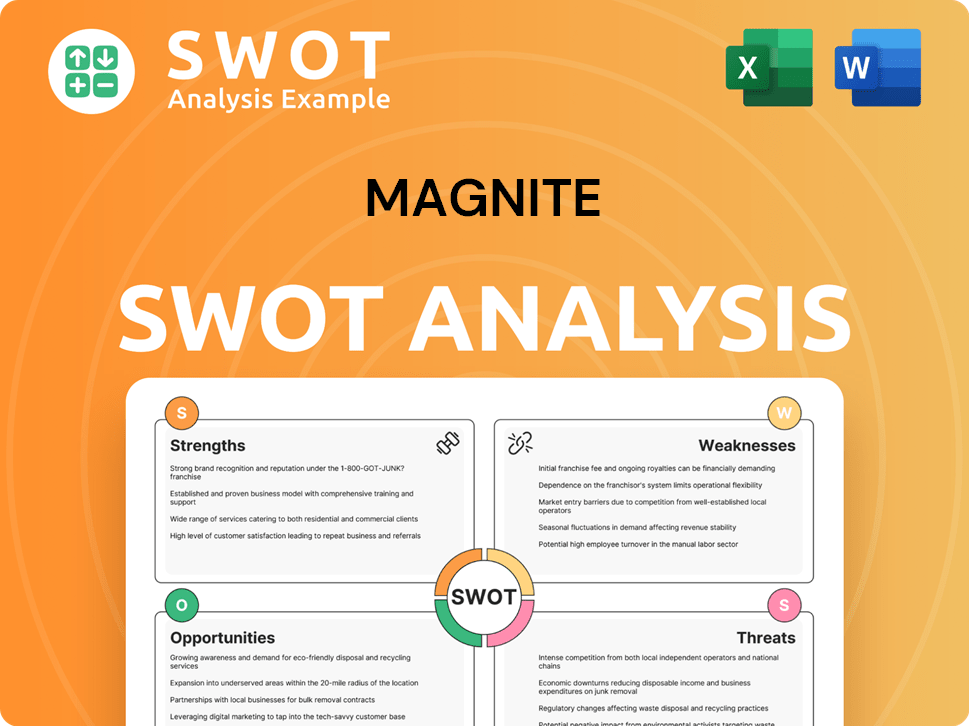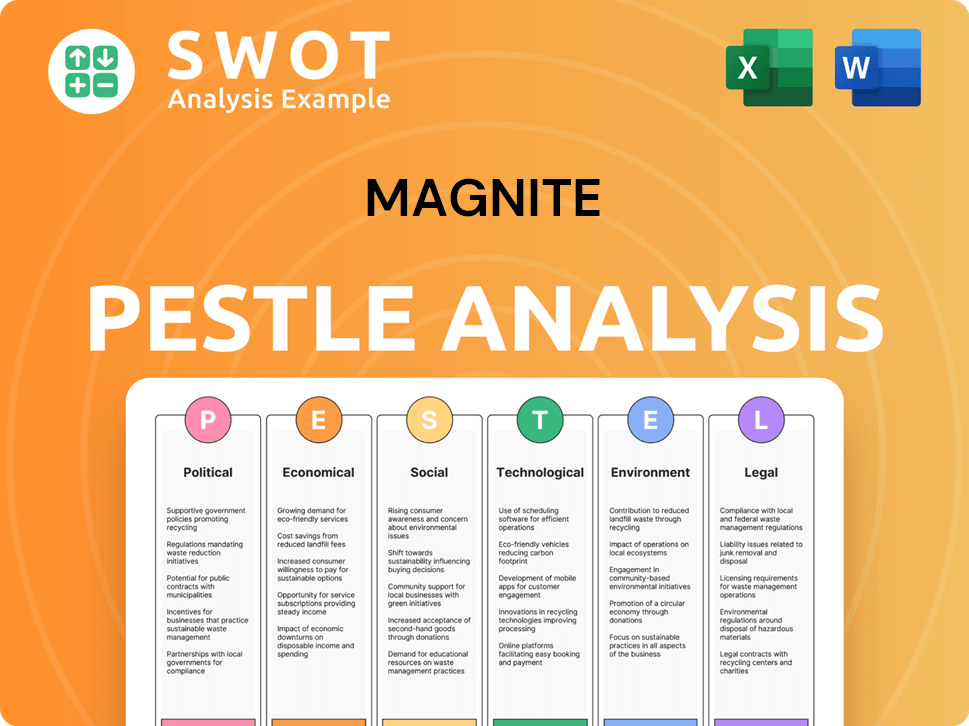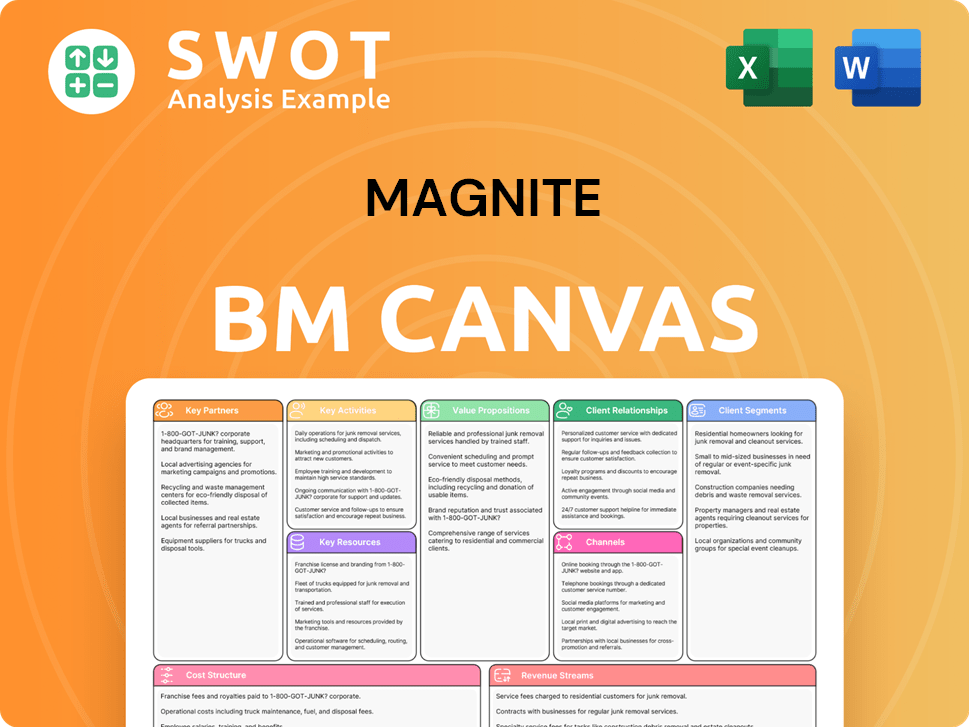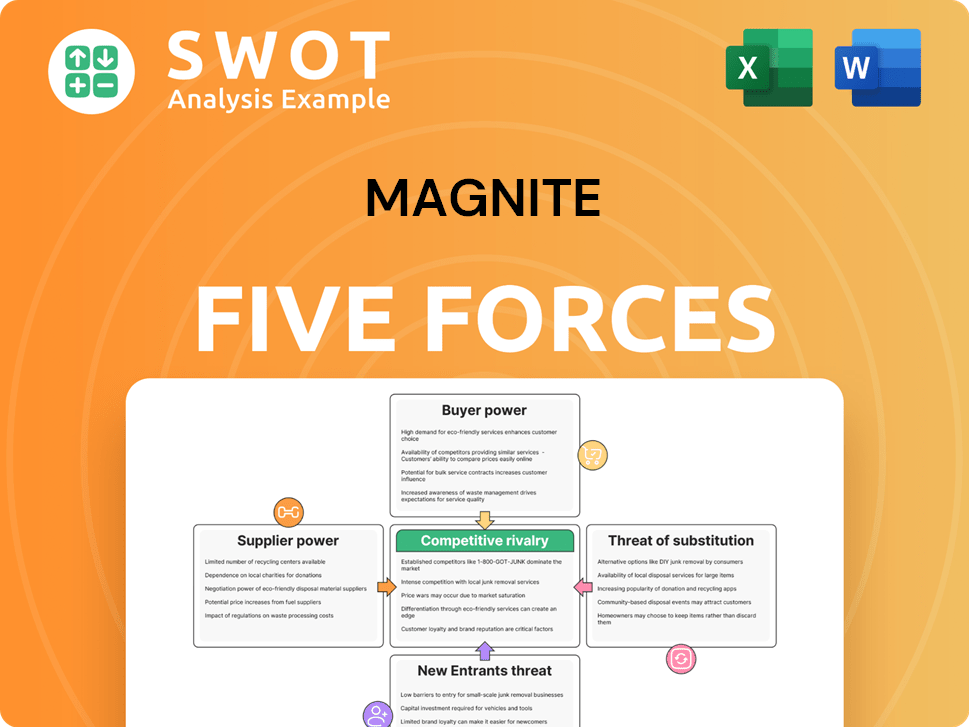Magnite Bundle
Who Really Controls Magnite?
Understanding the ownership structure of a company is crucial for investors and strategists alike. Magnite, a leading force in the digital advertising world, emerged from a pivotal merger in 2020, reshaping the ad tech landscape. This deep dive into Magnite SWOT Analysis will uncover the key players shaping its future.

As the largest independent sell-side advertising platform, understanding who owns Magnite is vital for anyone looking to invest in Magnite stock or analyze its strategic direction. This analysis will explore the Magnite company ownership structure, from its early days to the current composition of its shareholders, including major investors and the influence of Magnite executives. We'll also examine how recent trends in Magnite ownership might impact its market share and financial performance in the competitive ad tech space.
Who Founded Magnite?
The story of Magnite, a prominent player in the ad tech industry, begins with its roots in the merger of Rubicon Project and Telaria in 2020. However, the foundational history of the company is traced back to Rubicon Project, which was established in 2007. This merger was a pivotal moment, shaping the company's trajectory and setting the stage for its current market position.
Rubicon Project, the precursor to Magnite, was founded by Frank Addante, Craig Roah, Duc Chau, and Julie Mattern. These individuals shared a common background, having previously worked together at L90/adMonitor, an online advertising network. Todd Tappin is also sometimes recognized as a co-founder. Their collective experience laid the groundwork for the development of the ad tech platform that would later evolve into Magnite.
Initially, Rubicon Project operated as an advertising technology firm, connecting publishers with advertisers through an automated platform, functioning as a traditional ad exchange. This automated approach was a significant innovation in the advertising industry, streamlining the process of buying and selling ad space. By April 2009, the company had secured $33 million in venture funding, with Clearstone Venture Partners, IDG Ventures Asia, and Mayfield Fund leading the investment rounds. Silicon Valley Bank also provided $8 million in venture debt, demonstrating early investor confidence in the company's potential.
The roots of Magnite trace back to Rubicon Project, founded in 2007 by Frank Addante, Craig Roah, Duc Chau, and Julie Mattern. They previously worked together at L90/adMonitor. This early experience shaped their approach to ad tech.
By April 2009, Rubicon Project had raised $33 million in venture funding. Clearstone Venture Partners, IDG Ventures Asia, and Mayfield Fund led the investment rounds. Silicon Valley Bank provided an additional $8 million in venture debt.
Magnite was officially formed in 2020 through the merger of Rubicon Project and Telaria. This merger combined the assets and market positions of both companies. The merger was a key event in the evolution of the company.
Rubicon Project initially functioned as an advertising technology firm. It connected publishers with advertisers through an automated platform, acting as a traditional ad exchange. This automated approach was a significant innovation.
Specific equity splits and detailed early agreements for the founders are not publicly available. The merger itself served as the initial capitalization for Magnite. This merger was crucial for the company's foundation.
The founders of Rubicon Project, which later became Magnite, were Frank Addante, Craig Roah, Duc Chau, and Julie Mattern. Todd Tappin is also sometimes listed as a co-founder. These individuals shaped the company's early direction.
Understanding the founders and early investors provides insight into the Competitors Landscape of Magnite. The initial funding rounds and the merger with Telaria were crucial for the company's growth. The merger in 2020 marked a significant turning point, consolidating resources and market presence. The founders' vision and early investments set the stage for Magnite's future in the ad tech industry. The company's history reveals its evolution from an ad exchange to a major player in the digital advertising space.
- The merger of Rubicon Project and Telaria in 2020 formed Magnite.
- Rubicon Project raised $33 million in venture funding by April 2009.
- Founders include Frank Addante, Craig Roah, Duc Chau, and Julie Mattern.
- Early operations focused on connecting publishers and advertisers.
Magnite SWOT Analysis
- Complete SWOT Breakdown
- Fully Customizable
- Editable in Excel & Word
- Professional Formatting
- Investor-Ready Format

How Has Magnite’s Ownership Changed Over Time?
The evolution of Magnite's ownership has been shaped by key strategic moves since its inception in 2020. Initially formed through the merger of Rubicon Project and Telaria, the company has grown significantly. As a publicly traded entity on Nasdaq (MGNI), its ownership is a mix of institutional, insider, and retail investors. As of June 11, 2025, the company's stock price was at $17.68, a rise of 27.56% from $13.86 on June 12, 2024.
The structure of who owns Magnite has been influenced by several acquisitions. The purchase of SpotX in February 2021 for $1.17 billion and SpringServe for $31 million further solidified Magnite's position in the video advertising market, especially in Connected TV (CTV). These strategic moves have expanded its market reach and enhanced its technological capabilities, affecting the distribution of shares among various investor groups.
| Metric | As of Date | Details |
|---|---|---|
| Institutional Ownership | April 17, 2025 | 615 institutions collectively held 156,807,449 shares. |
| Institutional Ownership | March 30, 2025 | Approximately 77.85% of the company's stock is owned by institutional investors. |
| Insider Ownership | March 30, 2025 | Insiders hold about 3.03% of the stock. |
| Institutional Ownership | February 28, 2025 | Institutional ownership was at 87.77% (124.13 million shares). |
| Insider Ownership | February 28, 2025 | Insiders held approximately 6% (8.58 million shares). |
The major investors in Magnite, as of March 30, 2025, include Vanguard Group Inc. with 9.74% ownership, Capital Research Global Investors with 9.16%, BlackRock, Inc. with 6.94%, Fmr Llc with 6.89%, and Wellington Management Group Llp with 4.18%. These institutional investors play a significant role in shaping the company's strategic direction and financial performance.
Magnite's ownership is largely dominated by institutional investors, reflecting confidence in its growth potential within the digital advertising sector.
- Institutional investors hold the majority of shares.
- Strategic acquisitions have expanded Magnite's market presence.
- The stock price has shown growth, indicating positive investor sentiment.
- Key institutional shareholders include Vanguard, Capital Research, and BlackRock.
Magnite PESTLE Analysis
- Covers All 6 PESTLE Categories
- No Research Needed – Save Hours of Work
- Built by Experts, Trusted by Consultants
- Instant Download, Ready to Use
- 100% Editable, Fully Customizable

Who Sits on Magnite’s Board?
The current composition of the Board of Directors at the Magnite company includes a mix of individuals representing major shareholders, company leadership, and independent voices. Michael Barrett currently serves as the President & CEO of Magnite. Specific details on the individual equity split of board members are not readily available in the provided search results.
As a publicly traded entity, Magnite operates with a general one-share-one-vote structure for its common stock (Nasdaq: MGNI). However, the significant institutional ownership, which as of late 2024 holds around 87% of the company's shares, indicates that these large institutional investors can significantly influence board decisions and overall company policy. The collective power of investment firms, mutual funds, and other financial institutions is considerable, even though hedge funds are not identified as major owners.
| Board Member | Title | Notes |
|---|---|---|
| Michael Barrett | President & CEO | |
| (Information not available) | Board Member | Represents major shareholders, company leadership, and independent voices. |
| (Information not available) | Board Member | Represents major shareholders, company leadership, and independent voices. |
The influence of major institutional holders like Vanguard Group Inc., BlackRock, Inc., and Capital Research Global Investors, who collectively hold a substantial portion of shares, naturally impacts decision-making within the company through their voting power in shareholder meetings and their engagement with management. Information regarding recent proxy battles, activist investor campaigns, or governance controversies specific to Magnite in the 2024-2025 timeframe is not prominently detailed in the provided search results.
Understanding the ownership structure of Magnite is crucial for investors and stakeholders. Institutional investors hold a significant portion of the company's shares, influencing key decisions. The board of directors includes a mix of representatives from major shareholders and company leadership.
- Magnite is a public company.
- Institutional investors hold approximately 87% of the shares.
- Michael Barrett is the current CEO.
- Major investors include Vanguard Group Inc., BlackRock, Inc., and Capital Research Global Investors.
Magnite Business Model Canvas
- Complete 9-Block Business Model Canvas
- Effortlessly Communicate Your Business Strategy
- Investor-Ready BMC Format
- 100% Editable and Customizable
- Clear and Structured Layout

What Recent Changes Have Shaped Magnite’s Ownership Landscape?
Over the past few years, the focus of the Magnite company has been on strategic expansion, primarily through acquisitions, and enhancing shareholder value via share buyback programs. A significant move was the acquisition of SpotX in February 2021, which cost $1.17 billion and bolstered its video advertising capabilities. Additionally, the acquisition of SpringServe further strengthened its position in the Connected TV (CTV) sector.
Regarding Magnite ownership, institutional investors remain the key stakeholders. As of December 31, 2024, institutional investors controlled about 87.77% of the shares, totaling 124.13 million shares, indicating strong confidence from these investors. For instance, as of April 17, 2025, 615 institutions held a total of 156,807,449 shares. Key institutional holders include Vanguard Group Inc., BlackRock, Inc., and Capital Research Global Investors. Insider ownership, though smaller, also plays a role, with insiders holding approximately 6% or 8.58 million shares as of February 28, 2025.
| Metric | Details | Date |
|---|---|---|
| Institutional Ownership | Approximately 87.77% | December 31, 2024 |
| Shares Held by Institutions | 156,807,449 | April 17, 2025 |
| Insider Ownership | Approximately 6% | February 28, 2025 |
Magnite stock buyback programs reflect a commitment to managing shareholder dilution and returning value to investors. The company's revenue for the trailing twelve months (TTM) as of 2025 was $0.67 billion USD, an increase from $0.66 billion USD in 2024. From January 1, 2025, to March 31, 2025, the company repurchased 698,000 shares for $9.01 million under the buyback program. For the full year 2024, the repurchase program and 'withhold to cover' activity reduced dilution by 3.2 million shares for $37 million, limiting the increase in total shares outstanding to 2% compared to the end of 2023. Further insights into the company's strategic direction can be found in this article about Growth Strategy of Magnite.
Magnite announced an equity buyback plan on February 7, 2024, authorizing up to $125 million worth of common stock or convertible senior notes valid until February 6, 2026.
The company's revenue for the trailing twelve months (TTM) as of 2025 was $0.67 billion USD, an increase from $0.66 billion USD in 2024.
From January 1, 2025, to March 31, 2025, the company had repurchased 698,000 shares for $9.01 million under this program.
As of February 26, 2025, the company had $110 million remaining in its authorized share repurchase program.
Magnite Porter's Five Forces Analysis
- Covers All 5 Competitive Forces in Detail
- Structured for Consultants, Students, and Founders
- 100% Editable in Microsoft Word & Excel
- Instant Digital Download – Use Immediately
- Compatible with Mac & PC – Fully Unlocked

Related Blogs
- What are Mission Vision & Core Values of Magnite Company?
- What is Competitive Landscape of Magnite Company?
- What is Growth Strategy and Future Prospects of Magnite Company?
- How Does Magnite Company Work?
- What is Sales and Marketing Strategy of Magnite Company?
- What is Brief History of Magnite Company?
- What is Customer Demographics and Target Market of Magnite Company?
Disclaimer
All information, articles, and product details provided on this website are for general informational and educational purposes only. We do not claim any ownership over, nor do we intend to infringe upon, any trademarks, copyrights, logos, brand names, or other intellectual property mentioned or depicted on this site. Such intellectual property remains the property of its respective owners, and any references here are made solely for identification or informational purposes, without implying any affiliation, endorsement, or partnership.
We make no representations or warranties, express or implied, regarding the accuracy, completeness, or suitability of any content or products presented. Nothing on this website should be construed as legal, tax, investment, financial, medical, or other professional advice. In addition, no part of this site—including articles or product references—constitutes a solicitation, recommendation, endorsement, advertisement, or offer to buy or sell any securities, franchises, or other financial instruments, particularly in jurisdictions where such activity would be unlawful.
All content is of a general nature and may not address the specific circumstances of any individual or entity. It is not a substitute for professional advice or services. Any actions you take based on the information provided here are strictly at your own risk. You accept full responsibility for any decisions or outcomes arising from your use of this website and agree to release us from any liability in connection with your use of, or reliance upon, the content or products found herein.